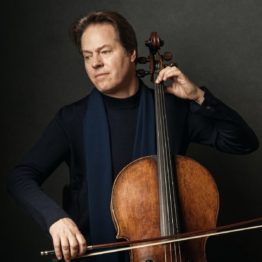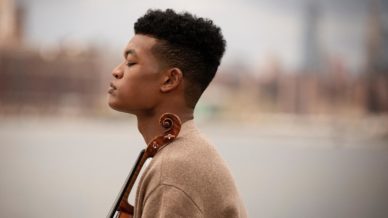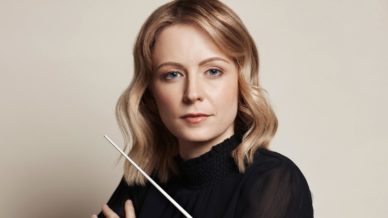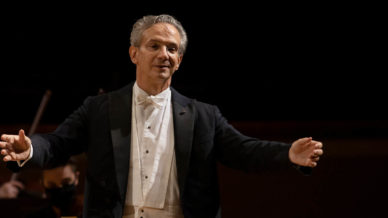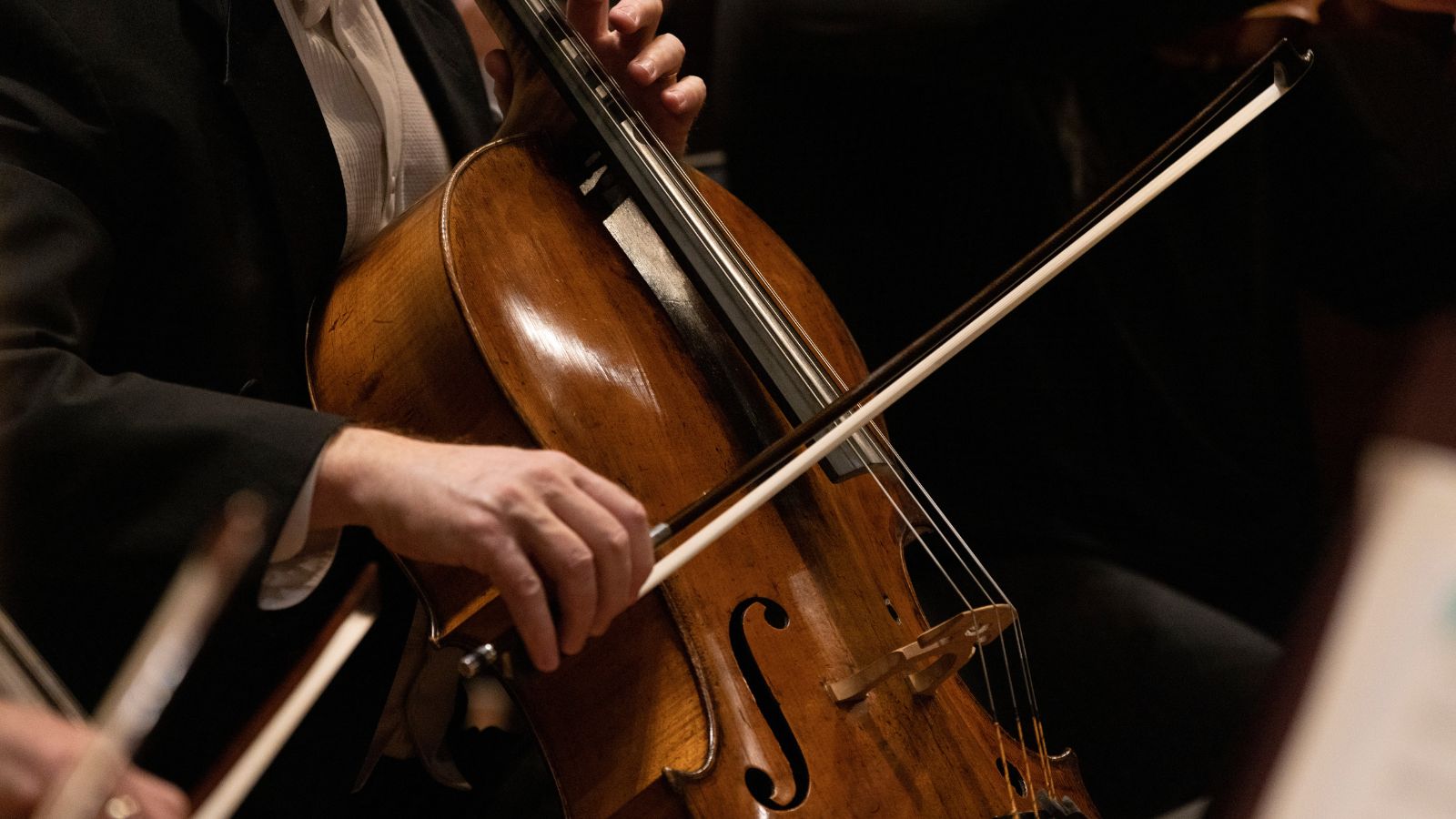

Don Quixote
September 29 – October 2, 2022
FABIO LUISI conducts
JAN VOGLER cello
R. STRAUSS Don Quixote
TCHAIKOVSKY Symphony No. 5 in E minor
Embark on a grand musical journey with Strauss’s Don Quixote. Cellist Jan Vogler plays the central role of Cervantes’s beloved Don, with other instruments representing various characters throughout including the brass taking a turn as a herd of sheep. The famous viola solo in Don Quixote features DSO’s very own, Meredith Kufchak, Principal Viola.
Luisi then leads Tchaikovsky’s emotionally charged Fifth Symphony, which transports listeners from dark despair to triumphant light. Like many of Tchaikovsky’s works, it finds him wrestling with fate and self-doubt and finding release in acceptance.
“Jan Vogler leads radiant performances of Tchaikovsky’s strong works”
The Strad

Program Notes
by René Spencer Saller
Richard Strauss was a busy conductor and a prolific composer who always found
time to read. From early adolescence until his death at 85, he read widely and
deeply: Nietzsche, Wilde, Sophocles, Schopenhauer, Goethe and other major
thinkers inspired many of his greatest works. For Don Quixote Strauss translated
Miguel de Cervantes’s eternally modern 17th-century novel into a series of
symphonic flash cards. Each of Strauss’s theme-and-variation movements covers a
specific plot point and enriches our understanding of the book’s central
relationship: that of the titular hero and his sweet-tempered squire.
Strauss may have been, as his detractors insist, a godless, apolitical, opportunistic
aesthete, but he wasn’t shallow. Frequently misunderstood as bombastic and self-
aggrandizing, his autobiographical tone poem Ein Heldenleben (A Hero’s Life)
glistens with irony, especially when heard alongside Don Quixote, as Strauss
intended. Together they make up a musical diptych: the delusional old knight tilts at
windmills; the quixotic composer swats at his critics. Both figures are equally
sublime and ridiculous.
By the time Strauss completed Don Quixote: Fantastic variations on a theme of
knightly character, in December 1897, he was a confident practitioner of program
music, or, as he preferred to call his compositions from this period, tone poems. This
extraordinary run began in 1886, with Aus Italien, and included up to that point
Macbeth (1887), Don Juan (1889), Tod und Verklärung (1889), Till Eulenspiegel
(1895) and Also sprach Zarathustra (1896). Despite the dismal reception of his first
opera, the 33-year-old composer worked tirelessly as both a composer and a touring
conductor and pianist. He was deeply devoted to his wife, the temperamental
soprano Pauline de Ahna, and their little son, Franz Alexander. For Strauss, who
lived for his art and his family, this was happiness.
In the words of his creator, Cervantes, Don Quixote is a man who, “through his little
sleep and much reading, …dried up his brains in such sort as he lost wholly his
judgment. His fantasy was filled with those things that he read, of enchantments,
quarrels, battles, challenges, wounds, wooings, loves, tempests, and other
impossible follies.”
To call him insane is irrelevant. He’s the novel’s hero and its moral center, an avatar
of the creative imagination. Don Quixote the novel is about a character who is
possessed by chivalric romances, but it’s also about the rules of fictive engagement.
Just as Cervantes’ novel is about the pleasures and perils of reading—which it to say
that it’s about nothing so much as itself—Strauss’s tone poem is about the creative
possibilities of listening, music as a collaborative act.
A Closer Listen
Strauss’s seventh tone poem consists of ten brilliantly orchestrated variations
prefaced by an introduction and theme and succeeded by a finale. Strauss didn’t
conceive of Don Quixote as a concerto, but he did give a starring role to the cello,
which represents Don Quixote, and juicy solo parts for viola and oboe (as Sancho
Panza and the hero’s beloved Dulcinea, respectively).
Rather than attempt to summarize Cervantes’s intricate two-volume meta-fiction,
Strauss condenses the story to a dozen representative scenes. In the whimsical,
questing introduction, he uses muted instruments and odd dissonances to suggest
the grip that fiction exerts on the old gentleman of La Mancha. After presenting
three themes associated with the eponymous hero, Strauss moves on to the
pragmatic peasant Sancho Panza, whom he limns with bass clarinet and tenor tuba
before letting a chatty viola take over. As in the novel, the collision between the
high-minded ideals of Don Quixote and the earthy comedy of Sancho Panza equals
pure comedy gold.
Strauss’s genius for pictorialism enlivens every movement, beginning with the
scurrying, lurching, tumbling first variation, wherein Don Quixote unwisely decides
to attack a group of giants (actually windmills, as Sancho tries to tell him). Listen for
the windmills’ creaking blades (cello strings against the wood side of the bow); the
snorts and gasps of the hero’s elderly horse (brass); the old knight’s humiliating fall
(harp glissandi); the unceremonious thump of his body as it hits the ground
(timpani). In the second variation, a queasy pastorale, flutter-tongued brass imitates
the bleating sheep that the hero mistakes for invading armies. In the seventh a Duke
and Duchess trick the knight and squire into believing that they’re mounted on
flying steeds. A whooshing wind machine—state-of-the-art technology in 1897—
joins strident horns, sibilant winds, and rumbling timpani in fostering this delusion.
We’re in Don Quixote’s head but also outside it. A resolute pedal D reminds us that
they’re two blindfolded guys on hobby-horses who never leave the ground while
actual aristocrats laugh—at, not with, them.
His fateful Fifth Symphony confronts the Beethovenian implications of its number
head on. Its structure invites us to feel good, or at least better. Completed in 1888,
the four-movement symphony follows the “per aspera ad astra”—“through
hardships to the stars” — model that Beethoven had famously used in his own Fifth
Symphony: from minor to Major, from dark to light (or at least somewhat lighter),
from sorrow to celebration (of a qualified sort). Most commentators identify
Tchaikovsky’s main theme as a musical representation of fate; the composer
explicitly says so in a programmatic outline that he drafted during the early stages
of composition and later abandoned. Regardless of what it symbolizes, the theme is
tirelessly reiterated, revised and transformed. Through its many changes the
symphony reveals its secret self.
Chronically depressed and sexually repressed, Tchaikovsky was tormented by
doubt, and he allowed other people’s opinions to ravage his self-esteem. A decade
had elapsed since his Fourth Symphony (1878), and although his star had risen
during that time, thanks to his opera Eugene Onegin, the 1812 Overture, and other
hits, he feared that he was creatively bankrupt. In a letter to his main patron, he
admitted, “I want so much to show not only to others, but to myself, that I still
haven’t expired… I don’t know whether I wrote to you that I had decided to write a
symphony. At first it was fairly difficult; now inspiration seems to have deserted me
completely.” At another point, he confessed that he had to “squeeze it from my
dulled brain.”
Despite these difficulties, he was initially pleased with his Fifth Symphony. But when
critics and colleagues (even an otherwise supportive Johannes Brahms) advanced
any form of criticism, he wrote, “Neither [Brahms] nor the players liked the Finale,
which I also think rather horrible.” Not a month later, however, the Fifth was back in
its creator’s good graces: “The Fifth Symphony was beautifully played and I have
started to love it again—I was beginning to develop an exaggerated negative
opinion about it.”
Crisis of Confidence
Tchaikovsky suffered from chronic self-loathing. He was deeply conflicted: a
conventionally religious man who couldn’t repress his homosexuality, no matter
how hard he tried to conform. He channeled his frustrations into his work, but like
most relentless perfectionists, he was seldom satisfied. He tried to kill himself at
least once, and some research suggests that his sudden death, at age 53, about five
years after finishing his Fifth Symphony, might have been a form of suicide. Other
Tchaikovsky scholars maintain that the composer was just another casualty of
cholera: one unfortunate pathogen consumer among millions whose beverage
hadn’t been adequately boiled.
A Closer Listen
The so-called fate theme first appears in the opening measures as a mournful lament
sung by the clarinet. In the second movement, in the afterglow of an achingly pretty
horn and winds interlude, it barges in rudely aloft harsh brass blurts. (The orchestra
stops short for a moment, as if in shocked silence.) The third movement, an off-kilter
scherzo, staggers gamely, like a woozy prima ballerina; the theme sneaks back
toward the end, an ominous afterthought muttered by the winds. In the finale the
theme blazes out in a major mode and ignites a fever-dream march.

